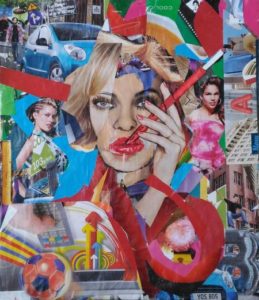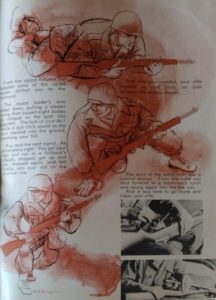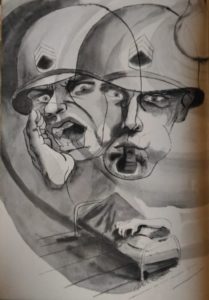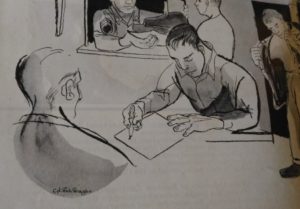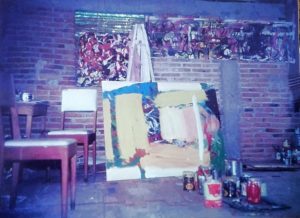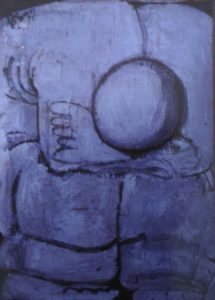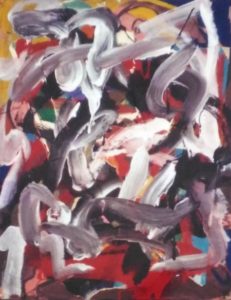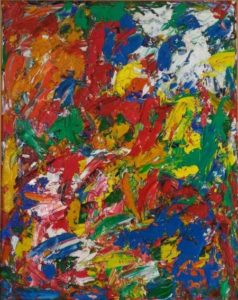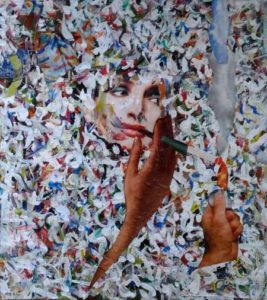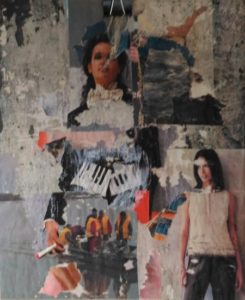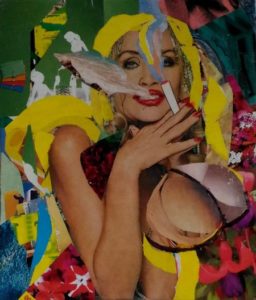Richard Hay Reagan had three great loves — art, jazz and Jeanora Bartlet. Jeanora is now a sprightly octogenarian and as we chat at her home in Bruton, Somerset, England, she is, initially, not too keen to share memories of her late partner.
I had originally sought out Jeanora because I wanted to learn more about when she had been photographed for a Life magazine article about foreigners living at Lake Chapala in Mexico in 1957. She was one of a handful of British expats then living there, and was pictured standing alongside another transplanted Brit — John Langley — an accomplished violinist and part-time artist [1], and the main reason for my visit.
Jeanora shares a few memories from her brief fling with Langley, but becomes far more animated when she starts to talk about “Rick” (clearly the love of her life) and the many years they enjoyed together in Mexico and elsewhere,
“How did you first meet?” I probe gently. Apparently, when Jeanora and John Langley drifted apart, he went to the coast, while she stayed on a while longer at Lake Chapala. In Ajijic she had become friends with artists Bhavani Escalante [2] and Don Martin. When Escalante moved to Mexico City, Bartlet soon followed. A year or so later, in about 1959, one of Escalante’s girlfriends – a tall, blonde, American lawyer named LaVerne — insisted on introducing her to an American painter named Rick Reagan, who was living in an apartment in San Angel in the southern part of the city. The bearded, good-looking artist was busy, painting a huge canvas on the floor, watched by some friends. But it was love at first sight and Jeanora and Rick quickly became inseparable.
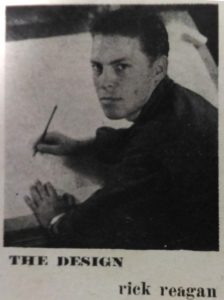
In Mexico City, they moved in the same circles as members of the city’s nascent modern art movement and those members of the Beat generation who had migrated there from California. Their friends included poet Philip LaMantia [3] and the poet and photographer Anne McKeever [4], who plays a key part in Rick’s later story.
Early Life – Los Angeles
Richard Hay Reagan had been born in Los Angeles, California, on January 18, 1929. He was the middle son of three boys born to George Reagan, a merchant in the heating industry who grew up in Philadelphia, Pennsylvania, and his diminutive English wife, Roberta Wright-Hay, who was born in 1891 in what was then Dacca, India (now Dhaka, Bangladesh). Roberta had spent her youth in the U.K. before moving to Los Angeles in 1925.
Rick’s older brother, George Peter Reagan (1927-2009), known as “Pete,” was a jazz musician, flautist and saxophone player, fireman and farmer who lived in Cathedral City, California. His younger brother, Robert G. Reagan (born September 1933), was the L.A. Diocesan press agent until 1974, and later became the spokesperson for the L.A. Public Library system. Throughout his life, Rick idolized his older brother, Pete, but rarely mentioned his younger brother, “Snorts.” [5]
As for his early education, Rick, late in life, recalled that, “I failed my first I.Q. test. I remember they were kind enough to check it out with me, probably because my older brother got one [mark] under genius. They asked me why I’d colored the grass purple and the sky orange and I told them I thought the teacher would like to see something different. They said “It’s to see if you can read”. I said, “Of course I can read. Why didn’t you just ask me?
“This was 32nd Street School opposite USC [University of Southern California]. It was an experimental ‘free expression’ school. The experiment was a failure, right? And I never did learn to spell too well.” The anecdote confirms, though, that Rick was an independent thinker from an early age. Decades later, responding to a query about his request for U.S. Social Security, Rick maintained that “Forms and Tests” were “repugnant” to him.
As a teenager, Rick often saw his cousins and perhaps his earliest commercial art venture was drawing prizefighters for the posters announcing boxing matches, staged by his cousins in their improvised ring. Spectators were charged 25 cents admission to watch neighborhood kids knock each other about. One of Rick’s cousins was Muldoon Elder, born in 1935 and six years younger than Rick. Muldoon is a professional artist, poet and film producer who founded and ran the famous Vorpal Gallery (1962-2003) in San Francisco. As in Rick’s case, his mother was dead set against him becoming an artist, but Muldoon drew on the prior experience of his cousin to help achieve his ambitions.
What Rick really did like, evidenced even by his earliest memories, was jazz. This love of jazz no doubt contributed to his hero worship of Pete, his talented saxophone-playing older brother, though Pete left his music-playing behind when he became a family man. For his part, Rick found that listening to jazz stimulated his artistic creativity and originality. He much preferred listening to instrumental pieces rather than vocal numbers, and favored virtuoso saxophone and other instrumental sections over drum solos, turning down the volume during the latter. [6]
The family was not well off, so Rick visited used goods stores and sought out records that had been discarded from jukeboxes. The A sides with their vocal numbers were worn white by repeated use, but Rick was more interested in the instrumental B sides which he often found in original, cherry pink, condition. Living in southern California, far from the origins of jazz, Rick took every opportunity he could to attend concerts whenever the greats of the time were playing anywhere nearby.
Japan and Korea
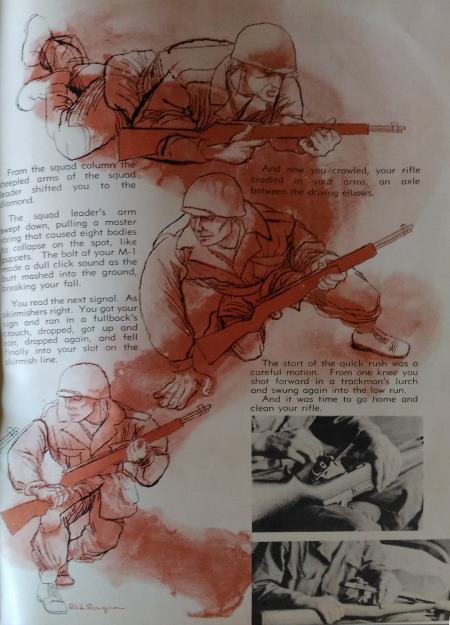
Rick was barely 21 years old when the U.S. went to war in Korea. Rick joined the 40th Infantry Division and served for three years, from 1950 to 1952. The Division went overseas in March 1951 and was stationed most of the time in Japan, undergoing intensive training, prior to entering Korea in the final stages of the conflict. True to form, Rick tried to slide by unnoticed, though he did advance one step from private to corporal.
Jeanora initially told me that he left little or no evidence of his stint in the Army. But, in fact, that is not quite true. While in Japan, Rick spotted a notice saying, “Volunteers needed to write the Division history” or words to that effect. Rick, the only man who volunteered, took the project on and was allocated materials and his own small hut, allowing him the chance to do his own thing, including his own art.
Published in 1952, the book, Fortieth in Review, is an extraordinary record of early 1950s warfare. Profusely illustrated with hundreds of drawings and photographs, it is a down-to-earth description of the formation, training and deployment of the 40th Division in Japan. Rick was responsible for the overall design, well ahead of its time, and for almost all the black-and-white illustrations that add so much energy and atmosphere to the book, considered to be one of the best American Division histories ever.
The better drawings are conspicuously signed “Cpl Rick Reagan.” Helping produce the book was writer Charlie Maher, who remained one of Rick’s close friends long after the war was over and became sports columnist for the LA Times. Another of Rick’s friends, Peter Chanin, who helped on the book went on to have a career as a cartoonist in New York. Rick poured his heart into this book and it was one of the few personal possessions that Rick kept close to him throughout his life, both a treasured memory of the past and easily-carried proof of his artistic flair and versatility.
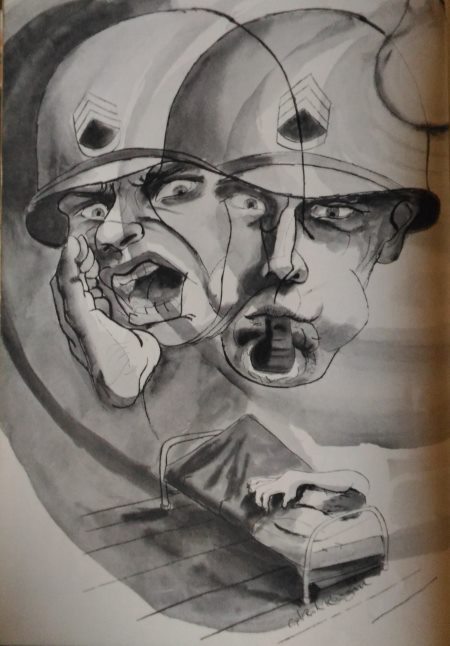
After Korea, Rick attended Jepson Art Institute in downtown Los Angeles. Between classes, he worked as a janitor at the school, and was also helped at this time by Gene Allen, who liked Rick’s art and went on to become the art director of “Let’s Make Love” (1960) and “My Fair Lady” (1962).
The 1950s were defining years for Rick, who had little ambition beyond his art.
While working a succession of temporary, dead-end jobs, he was pushed into marrying a girl from a wealthy Jewish family. They had a baby, but an unhappy Rick turned his back on his wife and child, and walked out. The couple divorced shortly afterwards.
Mexico
In the mid-1950s, after temporary jobs in California, Rick sought artistic inspiration in Mexico. He used GI Bill funds (then about $110 a month) to study art at Mexico City College, where he also taught and exhibited. More than once he spent time painting in the small fishing village of La Ventosa, in Oaxaca.
Among Rick’s friends in Mexico City was José L. Gutiérrez, who holds a prominent place in Mexican art history as the inventor (in 1953) of Politec Acrylic Artists’ Colors, one of the very first acrylic emulsion artists’ paints. Gutiérrez supplied his water-based acrylics to the big-name Mexican muralists, including Rufino Tamayo, David Alfaro Siqueiros and Diego Rivera. [7] Muldoon Elder recalls that Rick, like Siqueiros and several other artists of the time, often used Duco (an automotive paint) in place of conventional oil paint.
Rick always considered himself a “true artist, one who lived “moment by moment.” Influenced by Jackson Pollock and by the abstract art movement, and with his creativity heightened by a steady diet of jazz and local Mexican music, he used whatever materials came to hand for his artwork, completing, in his lifetime, thousands of collages, as well as drawings, oils and acrylics. Rick was a great fan of Carlos Castañeda’s fantastical books and many of his paintings are surrealistic. Some pieces are highly charged, verging on aggressive; others appear to be simply fun. While most of his collages seem pure Pop art, Rick would never have approved of this label since his artistic roots were in other schools of art and one of his main motivations for doing so many collages was the low cost of materials.
In keeping with his “true artist” conception, Reagan was neither interested in nor effective at self-promotion. Except in the early years, he rarely signed or dated his work. He considered much of his output to be work-in-progress and would often revisit a collage, sometimes years later, to realign, readjust, and refine its composition.
He held only a handful of shows in his career (only one documented show in his native U.S.) but did have gallery representation in the early 1960s with Walter Hopps in Los Angeles at the Ferus Art Gallery, best known as the gallery which gave Andy Warhol his first solo show. Unfortunately, Rick was later forced to sue the gallery because it “lost” some of his work. (Jeanora recalls that they lost “one piece,” Rick having opted to divide an especially large work into four smaller pieces for ease of transport to the gallery.) Rick won the suit, but the incident only served to reinforce his belief that he needed to distance himself from the formal commercial art world. As a result, very few collectors ever acquired his work, and very few have ever come up for auction. Late in life, Rick wrote what Jeanora calls his “manifesto” summarized in a paragraph that reads,
“Art is an ethical exercise. Rule one is “No self-promotion!” Rule two is, “Process not Goals!” (i.e. do things without thought of reward). Nostalgia is to be avoided at all costs…” He went on to criticize bureaucratic society for “doing what society always does to the artists, sapping our time and energy. We are never good enough for you. Hooray for the Consumer! Down with the Creator!”
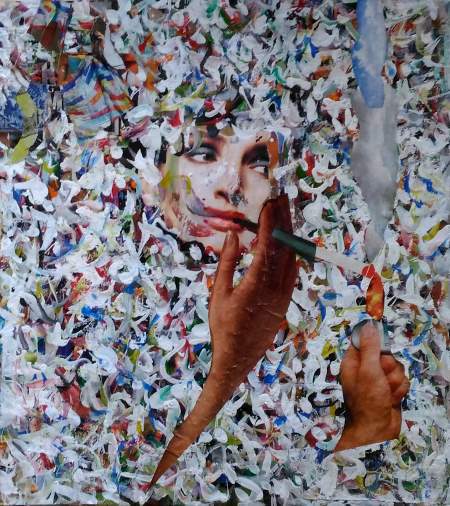
Soon after they met (in about 1959) Jeanora Bartlet and Rick lived for some months in La Ventosa, Oaxaca, where Rick had enjoyed painting previously. His return was especially valued by the local basketball team. Their stay in the village came to an end when Rick received a letter from an old friend, Bill Takas, urging him to join him in Europe. In 1961, Rick and Jeanora decided to cross the Atlantic.
“When I was in Ventosa I got a letter from a ‘friend’ saying I could sell all my work in Formentera. So I went up to L.A. to raise the fare. I left some stuff at the Ferus Gallery — there’s a story about that — anyhow I ended up selling seven years work to my brother for $300.” The two major collectors of Rick’s work at this time were his older brother, Pete, and Charlie Maher (the LA Times sports columnist), who had served with Rick in Japan.
Rick’s description of a “Hot summer day sitting in the sun in a little park in San Luis Obispo” (a city mid-way between Los Angeles and San Francisco) must correspond to this 1961 visit to Los Angeles:
“I was reading Herb Caen in the [San Francisco] Chronicle and in his column he used the word ‘Beatnik’. That’s when I started, and I sat there, bearded and sandaled and that. ‘Is that meant to be me? Hell, I’m 31 years old.’ I’d been down to the Union Hall to check in. Right across the street from it was a McDonald’s — 19 cent hamburgers — so many millions sold, the changing sign said. The two bros. sold out for a million and the new owners (it was the locations man, not the idea) proceeded to build the hamburger culture. But it didn’t start then. It started at Bob’s Big Boy in Glendale. Double decker hamburgers and malts thick enough to float a spoon. It was the ‘IN’ place. Everybody went there in their hot rods, chopped and chenille drapes and T-shirts with the sleeves rolled up — working on their tans. Brody knobs and pachucos wearing huaraches, mispronounced. Squeksqueack. The super cute bobby soxers, to impress the guys were there too, short skirts, sweaters on backwards.”
Europe (1961-1964)
Rick later summarized his three years in Europe:
— “Formentera was a fiasco. In Spain at that time Spaniards couldn’t even speak to foreigners, and the weather was awful. I’ve found out since it was some of the worst weather on record, so I decided to return to Mexico with my tail between my legs.” —
However, this brief account does less than justice to their time there, and, in the event, they would not actually return to live in Mexico for almost a decade.
Jeanora recalls their European trip in considerably more detail. After deciding to move across the Atlantic, while Rick took his completed paintings to Los Angeles to raise the funds for their passage, she hitchhiked and Greyhound-bused her way to New York, where they met up again.
From New York, they secured berths on a Yugoslavian cargo ship bound for Europe. They left the ship at Gibraltar, took a train to Algeciras and then local boats to Ibiza and the small island of Formentera, where Takas had rented the old school house for them near his studio.
The island attracted very few tourists at that time and Reagan found the art scene far too quiet, so a year or so later, they decided to try France, where one of Jeanora’s friends, an aristocrat, owned a chateau. Landing in Barcelona, Spain, they took the train up to Béziers and stayed at the friend’s Chateau D’Espondeleau for a couple of days.
When the time came to move on, they got a ride to the base of the Cevennes mountains and asked the local police, mayor and postman if they knew of anywhere for rent. They ended up finding a small two-room barn, partly full of farm implements, for five dollars a month. The barn, at a local beauty spot, Famourette, belonged to René Talasac, who also owned the adjacent vineyard, mid-way between two villages — Gignac and Aniane — near the city of Montpellier. The French love artists, and René quickly took a liking to both Rick and Jeanora. When a local cleric arrived and asked him to take in some recently-arrived Algerian refugees instead of the artists, he refused, replying “But artists must live too!”
Neither Rick nor Jeanora had any idea at the time that they had stumbled into the middle of a flourishing art scene. René’s brother, who had a boutique in Montpellier and collected art, arranged to hold a show of Rick’s collages there and the exhibition was a sell-out success despite Rick’s complete lack of French. The boutique owner continued to buy most of Rick’s work. Even though the paintings were sold for a song, their sale enabled Reagan to maintain a steady flow of supplies and new works.
Jeanora recalls how tough it was living there, especially over the winter, since all water had to be carried by hand from “the source” on the Herault River.
When it got too cold and snowed the following year, Jeanora and Rick moved on to Tangier, Morocco, which they absolutely loved. During their twelve months there, they met up again with their old Mexico City friend Philip Lamantia.
Notes
[1] John Langley was an accomplished violinist and part-time artist, born in the U.K. After moving to Canada, his promising career as a concert violinist ended when he lost a finger in a shooting accident. The insurance pay-out was sufficient for him to live in Mexico as a “remittance man.” [2] Now known as Bhavani Escalante, Lorraine (“Lori”) Fair, originally from Chicago, shared her house in Ajijic in the mid-1950s with the American artist Don Martin (who had a studio in the village from about 1954 to 1962). Today, this feisty 94-year-old lives in Albuquerque, New Mexico. She remembers Jeanora (“Chepa”) with fondness and is delighted to learn that I’ve been in touch with her. [3] Beat poet Philip LaMantia lived in Mexico City for several years. Rick and Jeanora met him again in Morocco in about 1963. [4] Beat poet and photographer Anne McKeever (1928-2002) was immortalized by jazz poet ruth weiss (who visited Mexico City in 1959) in her volume of verse, Gallery of Women, and in her poem “Post-Card 1995.” McKeever later married Humberto Javier Camacho, a former bullfighter. In 1960, the couple started a language school in Tapachula, Chiapas, close to the Guatemalan border. The language school is now being run by her grandsons. [5] Rick’s family: Richard Hay Reagan was born in Los Angeles, California, on January 18, 1929. He was the middle son of three born to George Reagan, a merchant in the heating industry who grew up in Philadelphia, Pennsylvania, and Roberta Wright-Hay, who was born in 1891 in what was then Dacca, India (now Dhaka, Bangladesh). Jeanora Bartlet recalls Roberta as a “diminutive Englishwoman” with a high-pitched, bird-like voice. Roberta spent her youth in the U.K. before moving to Los Angeles in 1925.Rick’s maternal grandfather was the Rev. Robert Wright Hay (1861-1943), born in 1861 at Sandhurst, Australia, to Scottish parents. The family moved to Saint Andrews, Scotland in 1869. Robert was apprenticed as a chemist (ages 13-19) before attending Edinburgh University and becoming a poet, minister and missionary. His poems were published in Chamber’s Journal, the Fifeshire Journal, People’s Friend and elsewhere. Four of his poems were included in “Modern Scottish Poets,” Seventh Series, published by D. H. Edwards in 1884. He married Adeline E. Wood (who died ca 1880) and worked as a missionary in Africa and in the Indian subcontinent.
Rick’s older brother, George Peter Reagan (1927-2009), known as “Pete”, was a jazz musician, flautist and saxophone player, fireman and farmer who lived in Cathedral City, California. During his stint in the U.S. Navy during the second world war, he played in a band in Hawaii (ca 1945) alongside the talented trombonist Frank Rehak. On March 9, 1951, at age 23, Pete married Betty Jean Simison, aged 19, in Los Angeles. Simison had been married previously and had one son (Michael Dennis Blunt, born November 14, 1949). Pete and Betty Jean had two children — Roberta Jean Reagan (born July 28, 1952) and Glenn Patrick Reagan (born November 15, 1957).
Rick’s younger brother, Robert G. Reagan (born September 1933), was the L.A. Diocesan press agent until 1974, and briefly named as a possible lay candidate to replace retiring Episcopalian Bishop Eric (“The Eagle”) Bloy. He was later (ca 1986-96) the spokesperson for the L.A. Public Library system. Robert married Barbara Bernice Fitzgerald in 1956. The couple had two children — Joanna and Robert Timothy (“Tim”).
[6] Rick’s hand-written notes make it clear that he heard almost all the big names in jazz of that time in live concerts, including Coleman Hawkings, Billy Eckstine, Lionel Hampton, Johnny Griffin, Gene Ammons, “Dizzy” Gillespie, Howard McGhee, Charlie Parker, Don Prell, Charlie Haden, Ornette Coleman, Oscar Pettiford, George Adams and Wendall Marshall. [7] José L. Gutiérrez holds a prominent place in Mexican art history as the inventor (in 1953) of Politec Acrylic Artists’ Colors, one of the very first acrylic emulsion artists’ paints. Gutiérrez supplied his water based acrylics to most of the big-name Mexican muralists, including Alfredo Torres Zalce (1908-2003), Rufino Tamayo (1899-1991), David Alfaro Siqueiros (1896-1974), Diego Rivera (1886-1957), Juan O’Gorman (1905-1982), Carlos Mérida (1891-1984) and Jorgé González Camarena (1908-1980). The new acrylic paints quickly replaced the solvent-based automotive lacquers previously used by muralists. See the webpage https://www.politecacrylics.com/artists-reviews/
